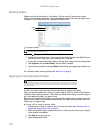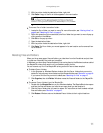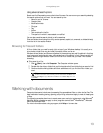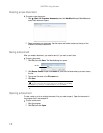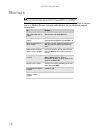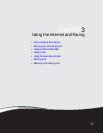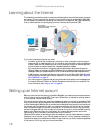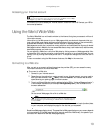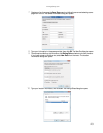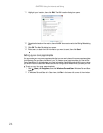
CHAPTER 3: Using the Internet and Faxing
18
Learning about the Internet
The Internet is a worldwide network of computers linked together to provide information to people
everywhere. The two most popular services on the Internet are e-mail and the World Wide Web.
You can access this network by connecting your computer to a telephone, DSL (Digital Subscriber
Line), or cable television line and signing up with an Internet service provider (ISP).
If you want to access the Internet you need:
• A modem—a device that connects your computer to other computers or servers using a
telephone, DSL, or cable television line. Your computer may have a built-in dial-up telephone
modem. Cable and DSL modems connect to your computer through an Ethernet jack and
provide a faster connection speed than a standard telephone modem.
• An Internet service provider—a company that provides access to the Internet through an
ISP server. When you connect to an ISP, the ISP server lets you access the Internet and your e-mail
messages. Check your telephone book for a list of Internet service providers available locally.
• A Web browser—a program that displays information from the World Wide Web. Microsoft
Internet Explorer was included with your computer. For more information, see “Using the
World Wide Web” on page 19.
• An e-mail program—a program that lets you create, send, and receive e-mail messages over
the Internet. Microsoft Outlook or Outlook Express was included with your computer. For
more information, see “Using e-mail” on page 20.
Setting up an Internet account
Before you can view the information on the World Wide Web, you need to set up an Internet account
with an Internet service provider (ISP). To set up an ISP service or to transfer an existing account
to this computer, contact the ISP directly.
Dial-up Internet connections are those using a telephone system to connect to the Internet. This
may include ordinary analog telephone lines, ISDN connections, and in some cases ADSL over PPP,
or other technologies. Because dial-up connections are designed to be temporary connections to
the Internet, dial-up charges (with both your telephone company and Internet service provider)
often increase the longer you connect to the Internet. To minimize the cost for dial-up Internet
service, we suggest that you only connect to the Internet during your e-mail and Web browsing
session, then disconnect when you are finished. Your Internet service provider can provide
instructions on how to connect to and disconnect from the Internet.
Cable and DSL modems, a connection known as broadband, use your cable television or special
telephone lines to connect to your ISP and access the Internet. In many instances, broadband is
considered an always-connected service. With this type of service, your cost is the same regardless
of the amount of time you use your Internet connection.
Your computer
connects to the Internet
through an ISP.
ISP Servers
let you connect to the Internet
and access your e-mail
messages.
Internet Servers
store information so other computers can
access it from the Internet.



